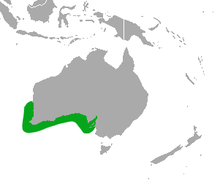Australian sea lion
test
| Australian sea lion | |
|---|---|

| |
| A family of Australian sea lions at Seal Bay Conservation Park, Kangaroo Island, South Australia | |
| Conservation status | |
| Scientific classification | |
| Kingdom: | Animalia |
| Phylum: | Chordata |
| Class: | Mammalia |
| Order: | Carnivora |
| Suborder: | Pinnipedia |
| Family: | Otariidae |
| Subfamily: | Otariinae |
| Genus: | ''Neophoca'' Gray, 1866 |
| Species: | ''N. cinerea'' |
| Binomial name | |
| Neophoca cinerea (Péron, 1816)
| |

| |
| Australian sea lion range | |
The Australian sea lion (Neophoca cinerea) also known as the Australian sea-lion or Australian sealion, is a species of sea lion that breeds only on the south and west coasts of Australia. It is monotypic in the genus Neophoca.
Phylogeny
[edit]The Australian sea lion is a pinniped, most closely related to other species of sea lions and fur seals in the family Otariidae.
Breeding behaviour
[edit]The breeding cycle of the Australian sea lion is unusual within the pinniped family. It is an 18-month cycle and is 'not' synchronised between colonies. The duration of the breeding season can range from five to seven months and has been recorded for up to nine months at Seal Bay on Kangaroo Island.
Bulls do not have fixed territories during the breeding season. The males fight other males from a very young age to establish their individual positions in the male hierarchy and during the breeding season, dominant males will guard females for the right to breed with her when she comes into oestrus. A female comes into season for about 24 hours within 7 to 10 days after she has given birth to her new pup. She will only look after the new pup and generally fights off the previous season's pup if it attempts to continue to suckle from her. Male Australian sea lions are also known to kill young as an act of defence of territory.
Australian sea lions also practice alloparental care, in which an adult may adopt the pup or pups of another. This might take place if the original parents die or are for some reason separated from them. This behavior is common and is seen in many other animal species such as the elephant and fathead minnow.[2]

Population status and protection measures
[edit]About 14,730 Australian sea lions remain.[3] This number is thought to be stable or slightly decreasing.[4] The Australian sea lion population is struggling due to their long and complicated breeding cycle, high site fidelity of females, and high mortality.
Sea lions were heavily hunted following European settlement, greatly reducing their numbers. Large-scale hunting ceased in the 1920s,[4] with harvesting being banned with the introduction of the South Australian National Parks and Wildlife Act 1972 which prohibited a harvest.
The Australian sea lion was listed as vulnerable under the Commonwealth Environment Protection and Biodiversity Conservation Act 1999 in 2005 and is also listed as a threatened species in each state in its range (South Australia and Western Australia). On 11 June 2013, the Recovery Plan for the Australian Sea Lion (Neophoca cinerea) was adopted by the Minister for Sustainability, Environment, Water, Population and Communities. The plan considers the conservation requirements of the species across its range and identifies the actions to be taken to ensure its long-term viability in nature and the parties that will undertake those actions.[5][6]
The Australian Fisheries Management Authority Commission has also finalised the Australian Sea Lion Management Strategy which came into force on 30 June 2010 which includes closures of waters around colonies, seasonal closures, increased observation of sea lion activity and trials of modified fishing techniques and equipment. The strategy is designed to meet the commission’s obligations under the Fisheries Management Act 1991 and the Environment Protection and Biodiversity Conservation Act 1999. The strategy will significantly reduce the impact of fishing in the SESSF on Australian sea lions and enable the recovery of the species, including all subpopulations.[7]
Ecology
[edit]Australian sea lions defecate nutrient-rich faeces which may provide an important nutrient source for coastal ecosystems. Metagenomic analysis of the bacterial consortia found in the faeces of Australian sea lions found very high levels of nutrient cycling and transport genes which may break down the nutrients defecated by sea lions into a bioavailable form for incorporation into marine food webs.[8]
References
[edit]- ^ Template:IUCN2008 Listed as Endangered (EN A2bd+3d)
- ^ Riedman, Marianne L. (December 1982). “The Evolution of Alloparental Care in Mammals and Birds”. The Quarterly Review of Biology 57 (4): 405-435
- ^ "Wildlife as Canon Sees It". National Geographic Magazine. 218 (6). National Geographic Society. December 2010.
Surviving number: Estimated at 14,730
- ^ a b http://www.environment.gov.au/cgi-bin/sprat/public/publicspecies.pl?taxon_id=22
- ^ "Recovery Plan for the Australian Sea Lion (Neophoca cinerea) 2013 Gazette - C2013G01027". Commonwealth of Australia. Retrieved 11 December 2014.
- ^ "Recovery Plan for the Australian Sea Lion (Neophoca cinerea)". Commonwealth of Australia, Department for the Environment. 2013. Retrieved 11 December 2014.
- ^ "Australian Sea Lion Management Strategy and SESSF Closure Direction No. 3". Australian Fisheries Management Authority Commission. Retrieved 11 December 2014.
- ^ Lavery TJ et al. 2012. High nutrient transport and cycling potential revealed in the microbial metagenome of Australian sea lion (Neophoca cinerea) faeces. PLoS One 7(5): e36478. doi:10.1371.journal.pone.0036478
Further reading
[edit]- Shannon Leone Fowler (2005). Ontogeny of diving in the Australian sea lion. Ph.D. thesis. University of California, Santa Cruz.
- Template:RefAudubonMarineMammals
- Pages using the JsonConfig extension
- IUCN Red List endangered species
- Articles with 'species' microformats
- Taxoboxes with the error color
- Taxobox articles possibly missing a taxonbar
- Eared seals
- Endemic fauna of Australia
- Megafauna of Australia
- Mammals of New South Wales
- Mammals of South Australia
- Mammals of Victoria (Australia)
- Mammals of Western Australia
- Animals described in 1816

